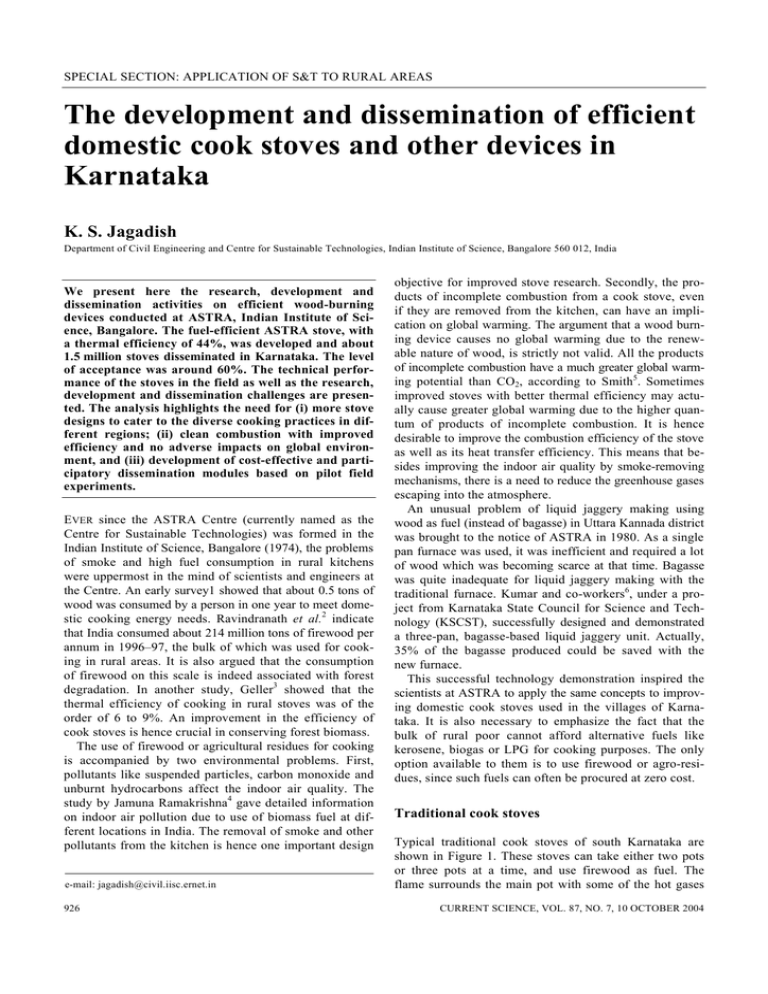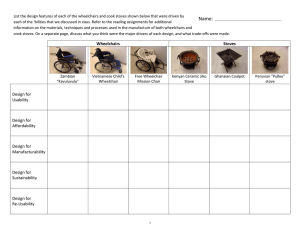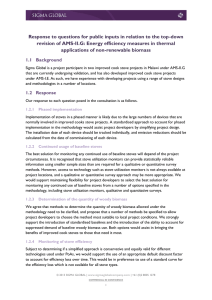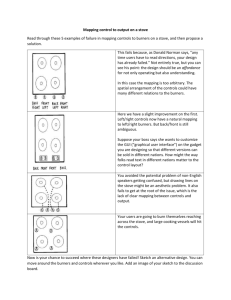The development and dissemination of efficient Karnataka K. S. Jagadish
advertisement

SPECIAL SECTION: APPLICATION OF S&T TO RURAL AREAS The development and dissemination of efficient domestic cook stoves and other devices in Karnataka K. S. Jagadish Department of Civil Engineering and Centre for Sustainable Technologies, Indian Institute of Science, Bangalore 560 012, India We present here the research, development and dissemination activities on efficient wood-burning devices conducted at ASTRA, Indian Institute of Science, Bangalore. The fuel-efficient ASTRA stove, with a thermal efficiency of 44%, was developed and about 1.5 million stoves disseminated in Karnataka. The level of acceptance was around 60%. The technical performance of the stoves in the field as well as the research, development and dissemination challenges are presented. The analysis highlights the need for (i) more stove designs to cater to the diverse cooking practices in different regions; (ii) clean combustion with improved efficiency and no adverse impacts on global environment, and (iii) development of cost-effective and participatory dissemination modules based on pilot field experiments. EVER since the ASTRA Centre (currently named as the Centre for Sustainable Technologies) was formed in the Indian Institute of Science, Bangalore (1974), the problems of smoke and high fuel consumption in rural kitchens were uppermost in the mind of scientists and engineers at the Centre. An early survey1 showed that about 0.5 tons of wood was consumed by a person in one year to meet domestic cooking energy needs. Ravindranath et al.2 indicate that India consumed about 214 million tons of firewood per annum in 1996–97, the bulk of which was used for cooking in rural areas. It is also argued that the consumption of firewood on this scale is indeed associated with forest degradation. In another study, Geller3 showed that the thermal efficiency of cooking in rural stoves was of the order of 6 to 9%. An improvement in the efficiency of cook stoves is hence crucial in conserving forest biomass. The use of firewood or agricultural residues for cooking is accompanied by two environmental problems. First, pollutants like suspended particles, carbon monoxide and unburnt hydrocarbons affect the indoor air quality. The study by Jamuna Ramakrishna4 gave detailed information on indoor air pollution due to use of biomass fuel at different locations in India. The removal of smoke and other pollutants from the kitchen is hence one important design e-mail: jagadish@civil.iisc.ernet.in 926 objective for improved stove research. Secondly, the products of incomplete combustion from a cook stove, even if they are removed from the kitchen, can have an implication on global warming. The argument that a wood burning device causes no global warming due to the renewable nature of wood, is strictly not valid. All the products of incomplete combustion have a much greater global warming potential than CO2, according to Smith5. Sometimes improved stoves with better thermal efficiency may actually cause greater global warming due to the higher quantum of products of incomplete combustion. It is hence desirable to improve the combustion efficiency of the stove as well as its heat transfer efficiency. This means that besides improving the indoor air quality by smoke-removing mechanisms, there is a need to reduce the greenhouse gases escaping into the atmosphere. An unusual problem of liquid jaggery making using wood as fuel (instead of bagasse) in Uttara Kannada district was brought to the notice of ASTRA in 1980. As a single pan furnace was used, it was inefficient and required a lot of wood which was becoming scarce at that time. Bagasse was quite inadequate for liquid jaggery making with the traditional furnace. Kumar and co-workers6, under a project from Karnataka State Council for Science and Technology (KSCST), successfully designed and demonstrated a three-pan, bagasse-based liquid jaggery unit. Actually, 35% of the bagasse produced could be saved with the new furnace. This successful technology demonstration inspired the scientists at ASTRA to apply the same concepts to improving domestic cook stoves used in the villages of Karnataka. It is also necessary to emphasize the fact that the bulk of rural poor cannot afford alternative fuels like kerosene, biogas or LPG for cooking purposes. The only option available to them is to use firewood or agro-residues, since such fuels can often be procured at zero cost. Traditional cook stoves Typical traditional cook stoves of south Karnataka are shown in Figure 1. These stoves can take either two pots or three pots at a time, and use firewood as fuel. The flame surrounds the main pot with some of the hot gases CURRENT SCIENCE, VOL. 87, NO. 7, 10 OCTOBER 2004 SPECIAL SECTION: APPLICATION OF S&T TO RURAL AREAS finding their way to the neighbouring pot/pots. The efficiencies are generally quite low and are of the order of 10%. The kitchens are usually blackened with smoke. A masonry hood-chimney is sometimes provided, which helps in sucking the smoke upwards. The reasons for the low efficiency are not difficult to seek. The main reasons may be listed as: a. b. c. d. e. f. Loss of heat through unburnt volatiles. Radiation loss from the flame. Cooling effect due to excess air factor. Stove losses. Sensible heat lost from unburnt volatiles–air mixture. Incomplete combustion due to inadequate mixing of volatiles and air. The development efforts at ASTRA soon concentrated on correcting some of the problems in traditional stoves. Development of fuel-efficient ASTRA stove The initial design was a three-pan version, which was similar to the traditional stove type and also provided large surface area for heat transfer. Facilitation of proper combustion was achieved by having an enclosed burning, with controlled entry of primary and secondary air to optimize the excess air factor. A grate was introduced to define the zone of combustion. A chimney of suitable height and diameter was provided to create draught and to transport the smoke outside the kitchen. The influence of other design factors, like the space below the pots in the three pans was evaluated through Figure 1. a, b, Traditional stoves. CURRENT SCIENCE, VOL. 87, NO. 7, 10 OCTOBER 2004 water-boiling tests. For instance, when the gaps below the three pots were changed from (15, 15 and 15 cm) respectively, to (12.5, 4.5 and 2.5 cm), the overall water-boiling efficiency increased from 23.6 to 44.2%. These studies showed the importance of the internal geometry of the stove in maximizing heat transfer to the pots. These variables influence the efficiency of the stove through modification of the following factors: a. b. c. d. View factor for radiative heat transfer. Heat transfer by convective mechanism. Provision of proper combustion volume. Excess air factor. Further improvements were made by enclosing the firewood in a closed box to prevent excess air from entering. The inner lining of the stove was made using a simple insulating material like clay mixed with paddy husk. In the final configuration, the ASTRA stove (also known as ASTRA ole in Kannada) had the following spaces below the three pots: first pot, 11.00 cm; second pot, 4.0 cm and third pot 2.5 cm. Often some households preferred two-pan stoves. In such cases, the space below the first pot was again 11.0 cm, while the space below second pot was 2.5 cm. Generally, a chimney of 7.5 cm diameter and height 2.5–3.0 m was used. Figure 2 shows a typical section of the ASTRA stove. Figure 3 shows an ASTRA stove in use in Ungra village. The ASTRA stove also has another advantage. It permits the use of a modified cooking practice for better efficiency due to the heat stored in the body of the mud stove. Once the third pan boils for about 5 min, the firewood may be withdrawn and the primary air inlet may be closed. This will lead to the cooking of wood through utilization of heat stored in the stove. In one of the cooking experiments it was found that the specific fuel consumption (per kilogram of food cooked) in the ASTRA stove was one-fourth of the value obtained in a traditional stove. The tremendous potential of the ASTRA stove in achieving high operational efficiency along with smoke removal became quite clear. Details of the ASTRA stove development have been discussed by Kumar et al.7. Figure 2. ASTRA stove: A cross-section. 927 SPECIAL SECTION: APPLICATION OF S&T TO RURAL AREAS The dissemination of the ASTRA stove The stove was given the Kannada name ‘ASTRA ole’, to make it familiar among the rural users. A pilot dissemination of the stove was carried out in three locations in Karnataka, namely Ungra village, Kunigal Taluk, Anekal and Unchagi, Uttara Kannada district. About 100 stoves were built in rural households and users were adequately informed about the features of the new stove. There was an enthusiastic response from people at all the three locations. People were especially happy with the smokelessness of the stove. They also felt that there was a significant saving of fuel. A major stove dissemination programme was launched in 1984–85 with the support of the MNES and the Government of Karnataka. KSCST became the nodal agency for dissemination. Initially, about 20 stove supervisors were trained in stove construction and use in each taluk. They were then deputed to the various districts to carry out training of stove builders. Then 15 to 20 stove-builders were trained in each taluk. The stove-builders were to be utilized by the local Block Development Officers in carrying out stove construction. The metallic parts and the pipe were supplied by fabricators/contractors to each taluk. About 20,000 stoves were built in Karnataka under this programme during 1984–85. About 50,000–80,000 stoves were built every year subsequently. About 15 lakh stoves have been built in rural homes in Karnataka during Figure 3. Table 1. 928 ASTRA stove in a village. Spread of efficient wood-burning devices developed at ASTRA Wood-burning device Numbers disseminated Cook stoves Large stoves Bath stoves Agro-product driers Agro-processing units Kilns 1,552,195 297 3315 856 3943 33 Total 1,560,639 the period 1984–2003 (Table 1). During the initial years, the stoves were subsidized to the tune of Rs 76 per household, while SC/ST households got them free of cost. The subsidy has been partially withdrawn in recent years. A few surveys were conducted from 1986 onwards in rural areas and a number of problems were discovered in the households using the ASTRA stove. The following list provides a broad picture of these problems: 1. Stove clearances were rarely maintained. 2. Fire box lid was rarely closed. It was often removed from the stove. 3. Pan openings were often found too large and reduced by mud plastering, increasing clearance below the pan. 4. Users complained about the problem of cutting wood into smaller lengths and the problem of not being able to use very small vessels. 5. Many complained about higher fuel consumption than the traditional stoves. 6. Stove top surface was not durable and the user could not repair it easily. 7. Housewives were never informed of the features of the new stove and often rejected the stove due to its unfamiliarity. 8. It was, however, generally accepted that the stove eliminates smoke from the kitchen. These observations made it clear that although the stove design offered several promises of efficient and smokefree cooking, the programme as implemented was incapable of delivering the promises. The author carried out a detailed survey in 1989 covering 40 taluks in Karnataka, with the assistance of Project Assistants employed by KSCST. About 224 villages were visited and all the stoves in these villages were surveyed. It was found that although 4704 stoves were built according to government records, only 3359 stoves were actually built. Table 2 shows the break-up of the stoves in use and stoves either demolished or not in use. The number of households retaining the traditional stoves is also given. Table 2 clearly shows that the acceptance of the ASTRA stove is approximately of the order of 60%. However, looking at the number of households retaining traditional stoves, it appears as though some of the stove-users are fence-sitters and are keeping their fingers crossed. A study by Shastry et al.8 also showed that the number of stove-users could decrease with the passage of time, although this reduction is not always due to unsatisfacTable 2. Survey of stove acceptance in 224 villages (1989) Stoves in use Food zone Stoves built Ragi zone 1483 Rice zone 664 Jowar roti zone 1110 No. % 992 356 629 66.9% 53.6% 56.7% Stoves Households demolished retaining or not used traditional stoves 491 308 481 624 444 623 CURRENT SCIENCE, VOL. 87, NO. 7, 10 OCTOBER 2004 SPECIAL SECTION: APPLICATION OF S&T TO RURAL AREAS tory stove performance. About 31% of the changes are caused by switching over to biogas or LPG or due to change of residence. The studies clearly indicated that although the stove design offered several promises of efficient and smokefree cooking, the programme implementation posed several problems leading to rejection of the stove in many households. It is useful to summarize some of the pitfalls which need to be addressed in planning such technology dissemination programmes. 1. First, cooking is a complex process which varies widely from region to region and among different segments of the society. The attempt to match a single stove design for all situations could then be problematic. For instance, in Dakshina Kannada district, cooking involves preparation of rice gruel (ganji in Kannada) in a rather large pot. The sizes of the stove openings provided according to the design turned out to be too small. There were no mechanisms to introduce design change to suit local cooking practice. Again, the stove-builders do not have an indepth understanding of the design parameters of the stoves and are incapable of introducing the changes necessary to make the stove successful. 2. Majority of the stove-trainees are not available for stove construction, since stove-building under government programmes does not ensure regular employment. Again, the trainees have little motivation in producing excellent stoves, since the returns are poor. It is also possible that a majority of the trainees lose their stove-building skills if they are not employed immediately after the training. In practice, the stoves are often built by persons who are not exposed to the training. The interior dimensions of the stove, which are crucial for its high performance are hence rarely adhered to. 3. The stove user is never informed about the ASTRA stove and the way in which it should be operated. Again, if the housewife has questions about stove performance, she can find nobody to answer her. The stove-builders vanish after building the stoves and the government has no mechanisms for getting a feedback. All these problems make it clear that for a successful stove programme the following steps are critical: a. An initial concept marketing is necessary to prepare the user to the new device. b. A good delivery system which takes care of after-sales service and feedback to the stove-building agency is essential. c. A chain of stakeholders in stove propagation needs to be established. Mechanism of feedback to the designer to affect changes in stove design to meet local conditions and transmission of these changes to the stove builders also needs to be established. In short, the government programme made rather naïve assumptions about the steps to be taken in the delivery of CURRENT SCIENCE, VOL. 87, NO. 7, 10 OCTOBER 2004 stoves to people and the complexities in the process were not understood. The recent approach to depend upon stakeholder entrepreneurs appears to be better. The silver lining The information presented in the previous section was fairly depressing to the stove designers. It must, however, be pointed out that there were several positive developments in the field which need to be taken note of. In the Sirsi area, Uttara Kannada district, the ASTRA stove was well accepted and started spreading through the entrepreneurship of a high-school teacher (R. K. Joshi). This activity started around the late eighties and now his son is continuing the work by taking up construction of stoves, areca nut processing stoves, driers and so on. The new wood-burning devices have been accepted both for their ability to remove smoke and to save fuel. The entrepreneured dissemination has built-in mechanisms for feedback and after-sales service, which are crucial for satisfactory spread of a new device. The sample of Sirsi is not a solitary one. An entrepreneur in the village of Masur in Hirekerur Taluk (K. Nagaraja) took up construction of ASTRA stoves. He was building stoves for a price of Rs 160 and was providing instruction and after-sales service to the users. A potter, (Mahagundappa Kumbhar), in the village of Belur near Badami, developed a pottery ASTRA stove consisting of three pieces to be assembled together. He had supplied this stove to many users. However, the government programmes are unable to utilize the services of this potter. Making pottery-based ASTRA stoves could be an excellent example of promoting rural industry using a contemporary device for local use. A recent survey in Ungra village showed that out of 110 households, the improved stove was retained in 108 households after eighteen years of implementation. However, 98 households modified the stove by removing the firewood box and by shifting the wood port to the front of the stove. This clearly shows that whenever the quality of implementation is good, the people tend to use the stove with modifications to make the stove more userfriendly. The Tibetan settlements in Karnataka represent another success story for the ASTRA stove. The Tibetan cooking practices seem to be well adapted to the ASTRA stove and both two-pan and three-pan devices are in use. The gaps in the stoves below the pans were quite close to the specification. The stove is also raised on a platform to facilitate convenient cooking. About 1600 stoves were built in Tibetan settlements by 1991. There were plans to implement the stoves in Arunachal Pradesh, Madhya Pradesh and Orissa in the Tibetan settlements. In response to some of the complaints of low efficiency, ASTRA also developed a modified stove which had 929 SPECIAL SECTION: APPLICATION OF S&T TO RURAL AREAS an exclusive water-heating pan before the chimney. Such stoves were designated as 1 + 1 or 2 + 1 stoves, the first number referring to the number of cooking pans and the second to the water-heating pan before the chimney. Several such stoves were installed in the field and showed good performance. Sarala ole The various surveys carried out during the first eight years of the improved stove programme in Karnataka, repeatedly showed the tendency of the users to modify the ASTRA ole to suit their conveniences and preferences. Invariably, they changed the fuel feeding to the front instead of the side and also removed the firewood box. They could now use wood pieces of any length and also easily observe the flame while cooking. Since this modification of the original ASTRA design was widely accepted by the people, it was felt that this design could be renamed as ‘sarala ole’ and all future dissemination could concentrate on this design. Accordingly, the author had a discussion with stove supervisors in 1993 and suggested that both ASTRA ole and sarala ole could be disseminated in villages depending on user preference. Some sarala oles using burnt clay top plates were disseminated in Magadi taluk and about 100 stoves have been built. A new innovation was carried out by (Murtuza Ali) the stove supervisor in Mysore. He developed a simple metallic mould in which mud could be shaped into a stove in about 1–1.5 h. The labour cost of construction came down and there was a better acceptance of the sarala ole in many villages of Mysore district. The sarala ole design by Ali incorporated some improvements like chamfered edge of the opening, which is useful when vessels of different sizes are to be used. However, the design also leads to two problems. The combustion volume below the first pan is significantly reduced since the lower diameter of the chamfered edge is quite small. Secondly, a large vessel in the first opening will have a vessel bottom-to-grate distance of 17.5 cm when a flat vessel is used. This is too large compared to the optimum value of 11.0 cm. It is hence desirable to reduce the depth of the chamfer so that the maximum distance between the vessel and the grate could be around 14 cm, while the minimum distance could be 10 cm. There is thus a need to continuously monitor modification by field supervisors to maintain the optimal performance of the modified stove. The switch-over from ASTRA ole to sarala ole also meant a reduction in the fuel efficiency of the stove. The author tested the sarala version and found that it had a water-boiling efficiency of 25–30% compared to the 40– 50% efficiency of the ASTRA stove. However, in view of the low efficiency of about 10% of the traditional stove, the sarala ole still gives a reduction in firewood consumption, while removing smoke. 930 There are now more than 5000 sarala oles in Mysore and Mandya districts using Ali’s mould. This version of the stove was picked up by TIDE (Technology Informatics and Design Endeavourer), Bangalore, and was disseminated in Bellary, Tumkur, Chikkamagalur and Dharwad districts. The stove was also demonstrated in Uttaranchal. The sarala ole was also disseminated by S. Raghuram, a freelance development consultant, in tribal areas of Chhattisgarh and Orissa. During a training programme in Mahasamand, Chhattisgarh about 150 stoves were constructed. The tribal villagers received the stove with great enthusiasm. In one of the training programmes in Koraput, Orissa the tribals tested the Sarala stove against their traditional stoves. It was found that the traditional stoves needed 7.5 kg of firewood per meal and 1.5 h of cooking duration. With the Sarala stove, only 2.5 kg of wood was consumed per meal and the time taken was 50 min. Other devices Significant amounts of firewood are consumed in rural/ urban areas for agro-processing and industrial operations. Areca processing stoves, stoves for silk reeling, steam distillation of essential oils are some of the areas where new concepts of efficient wood-burning can make an impact. Lokras9,10 developed a large number of such devices and disseminated them in Karnataka and Kerala. The use of wood for dehydration of agro-produce like cardamom, areca, coconut, etc.11 is another area where efficient devices can significantly improve the economy of the operations, besides improving the environment. An improved drier developed by Lokras has now been disseminated to NGOs and more than 856 agro-product driers have been constructed to process areca, cocoa beans, cardamom, banana and coconut. TIDE has also taken up dissemination of driers and large stoves. The concepts have been extended to improving the barns for curing tobacco. The extent of spread of different efficient woodburning devices developed at ASTRA is given in Table 1. A recent technological development in ASTRA is the production of stabilized mud blocks using lime. Lime stabilization requires accelerated curing using steam to generate temperatures around 80°C. An efficient woodbased steam generator was hence developed to cure limestabilized blocks over a 10 h operation. This technology is now under field trials. Reddy and Lokras12 have perfected the technology after two pilot studies. Conclusion The improved stoves/wood-burning devices programme in India, based on the R&D at ASTRA, is indeed a remarkable experiment in scientific research oriented towards the needs of society. The programme has clearly brought out the intricacies of social needs and how they need to CURRENT SCIENCE, VOL. 87, NO. 7, 10 OCTOBER 2004 SPECIAL SECTION: APPLICATION OF S&T TO RURAL AREAS be considered by researchers in developing an improved technology. The wood-burning devices research at ASTRA has indeed helped the largest number of rural households compared to other research activities at the Centre. However, there are a few unresolved issues which need to be addressed 3. 4. 5. a. The problems encountered in the villages in different regions make it clear that more stove designs need to be developed to cater to cooking practices of various regions/ communities. Use of portable stoves, charcoal stoves and environment-friendly charcoal production are other related issues which need to be examined. b. Although the stoves developed remove smoke from the kitchen, it is quite likely that undesirable volatiles are sent into the atmosphere. It is perhaps important to explore clean combustion mechanisms, which improve efficiency with no adverse impact on the global environment. Studies at Eindhoven University13 and experiments in Bangladesh14 indicate clean combustion possibilities with downdraft combustion. c. More detailed measurements of air quality around improved stoves are called for to establish cleanliness of the domestic environment. d. The dissemination of stoves in rural households is a complex process and all the ramifications of the management of such a process have not been understood. Dissemination modules which are cost-effective without affecting quality need to be developed. Pilot experiments in such implementation are probably necessary before finalizing a massive programme to reach millions of rural households. 1. Ravindranath, N. H., Nagaraju, S. N., Somashekar, H. I., Channeshwarappa, A., Balakrishna, N., Balachandran, B. N. and Reddy, A. K. N., An Indian village agricultural ecosystem – case study of Ungra village, Part I: Main observations. Biomass, 1981, 1, 61– 76. 2. Ravindranath, N. H., Usha Rao, K., Natarajan, B. and Pradeep CURRENT SCIENCE, VOL. 87, NO. 7, 10 OCTOBER 2004 6. 7. 8. 9. 10. 11. 12. 13. 14. Monga, Renewable Energy and Environment, Tata McGraw Hill, New Delhi, 2000, p. 18. Geller, H. S., Cooking in the Ungra area: Fuel efficiency, energy losses and opportunities for reducing firewood consumption. Report for ASTRA, Indian Institute of Science, February 1981. Jamuna Ramakrishna, Cooking in India: The impact of improved stoves on indoor air quality. Environ. Int., 1989, 15, 341–352. Smith, K. R., Health, energy and greenhouse gas impacts of biomass household stoves. Energy Sustain. Dev., 1994, 4, 23–29. Kumar, R., Lokras, S. S., Hegde, M. S. and Jagadish, K. S., Development, fabrication and commissioning of a community jaggery unit using bagasse as fuel. KSCST Project Report, August 1981. Kumar, R., Lokras, S. S. and Jagadish, K. S., Development, analysis and dissemination of a 3-pan cook stove, KSCST, Indian Institute of Science, Bangalore, October 1990. Shastri, C. M., Sangeetha, G. and Ravindranath, N. H., Dissemination of efficient ASTRA stove: Case study of a successful entrepreneur in Sirsi. Energy Sustain. Dev., 2002, III, 63–68. Lokras, S. S., A study on cocoon processing and silk reeling. National Conference on Wood-Based Energy Systems in Rural Industries, FAO, New Delhi, 1991. Lokras, S. S., Development of Fuel Efficient Large Wood Stoves. Food Processing (eds Potty, V. H. and Mulky, M. J.), Oxford & IBH Pub Co, Mumbai, 1993. Lokras, S. S., Development of fuel efficient drier for rural areas. 46th Annual Meeting, Indian Institute of Chemical Engineers, Mumbai, 1993. Reddy, B. V. V. and Lokras, S. S., Steam cured stabilized soil blocks for masonry construction. Energy Build., 1998, 29, 29–33. Khan, H. R., Dirks A. M. and Moerman, E., Wood combustion studies, Part II, Eindhoven University of Technology, Eindhoven, July 1991. Eusuf, M. and Khan, H. R., Downdraft tandur oven. Energy Sustain. Dev., 1994, 1, 35–38. ACKNOWLEDGEMENTS. The wood burning devices research at ASTRA was the result of a team effort lead by Prof. R. Kumar and S. S. Lokras. The other participants who contributed to the work are Prof. M. S. Hegde, D. S. Sudhakar Babu and Svati Bhogle. I thank Prof. S. S. Lokras for providing inputs and suggestions during the preparation of this manuscript. Prof N. H. Ravindranath and Dr Shailaja Ravindranath gave valuable support during the initial phases of the programme by carrying out training and monitoring activities. Financial support from KSCST, DST and MNES is acknowledged. 931





